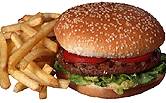
THURSDAY, May 23 (HealthDay News) — People who eat at fast-food restaurants are consuming significantly more calories than they realize — and teens are the worst offenders, a new study found.
“Teens underestimate the number of calories in their meals by as much as 34 percent, parents of school-age children by as much as 23 percent, and adults by as much as 20 percent,” study lead researcher, Dr. Jason Block, said in a news release from the Robert Wood Johnson Foundation, which helped fund the study.
Block, of the Harvard Medical School/Harvard Pilgrim Health Care Institute, and his colleagues surveyed nearly 3,400 adults, teens and children who ate at 89 fast-food restaurants in four New England cities.
The investigators compared the difference between the number of calories the participants thought was in the fast food they ordered with the actual number of calories in their meal.
The study, published May 24 in BMJ, found the meals ordered by adults contained an average of 836 calories. However, adults thought the food they ordered had 175 fewer calories.
Meanwhile, teens on average underestimated the number of calories in their 756-calorie meal by 259 calories. The study also showed that 25 percent of all participants underestimated the caloric content of their meals by at least 500 calories.
“We also saw differences by food chain,” Block said. Adults who ate at Subway were 20 percent less accurate in assessing the calories in the food they ordered than those who went to McDonald’s, Burger King, KFC (Kentucky Fried Chicken), Wendy’s and Dunkin’ Donuts. Teens who ate at Subway were 25 percent less accurate, the researchers added.
“These findings tell us that many people who eat at fast-food restaurants may not be making informed choices because they don’t know how many calories they’re consuming,” Block said. “Having the information is an important first step for anyone wanting to make changes.”
None of the chains involved in the study included nutritional information on their menus, the researchers pointed out.
Meanwhile, a second study suggests that calorie labels on menus or on restaurant menu boards are effective in prompting people to buy meals with fewer calories.
That study, published in the June American Journal of Preventive Medicine, examined the impact of menu-labeling regulation in King County, Wash.
The researchers surveyed more than 7,300 people aged 14 and older who dined at 10 restaurant chains, including Subway, McDonald’s, Taco Bell and Starbucks, before the law took effect, and again six and 18 months after the law was implemented.
Although no change in purchases was seen six months after the menu labeling law took effect, the study revealed that after 18 months, the average calories per purchase at chain restaurants fell by 38 calories, from 908 calories to 870 calories.
“Menu labeling is critical because Americans spend nearly half of their food dollars on foods prepared outside the home, which tend to be higher in calories and less healthy than what we eat at home,” said researcher Dr. James Krieger, with Public Health–Seattle & King County, in the news release. “Over time, people seem to respond to the availability of information and use it to inform their purchases.”
More information
Visit the U.S. Centers for Disease Control and Prevention for information on balancing calories.

